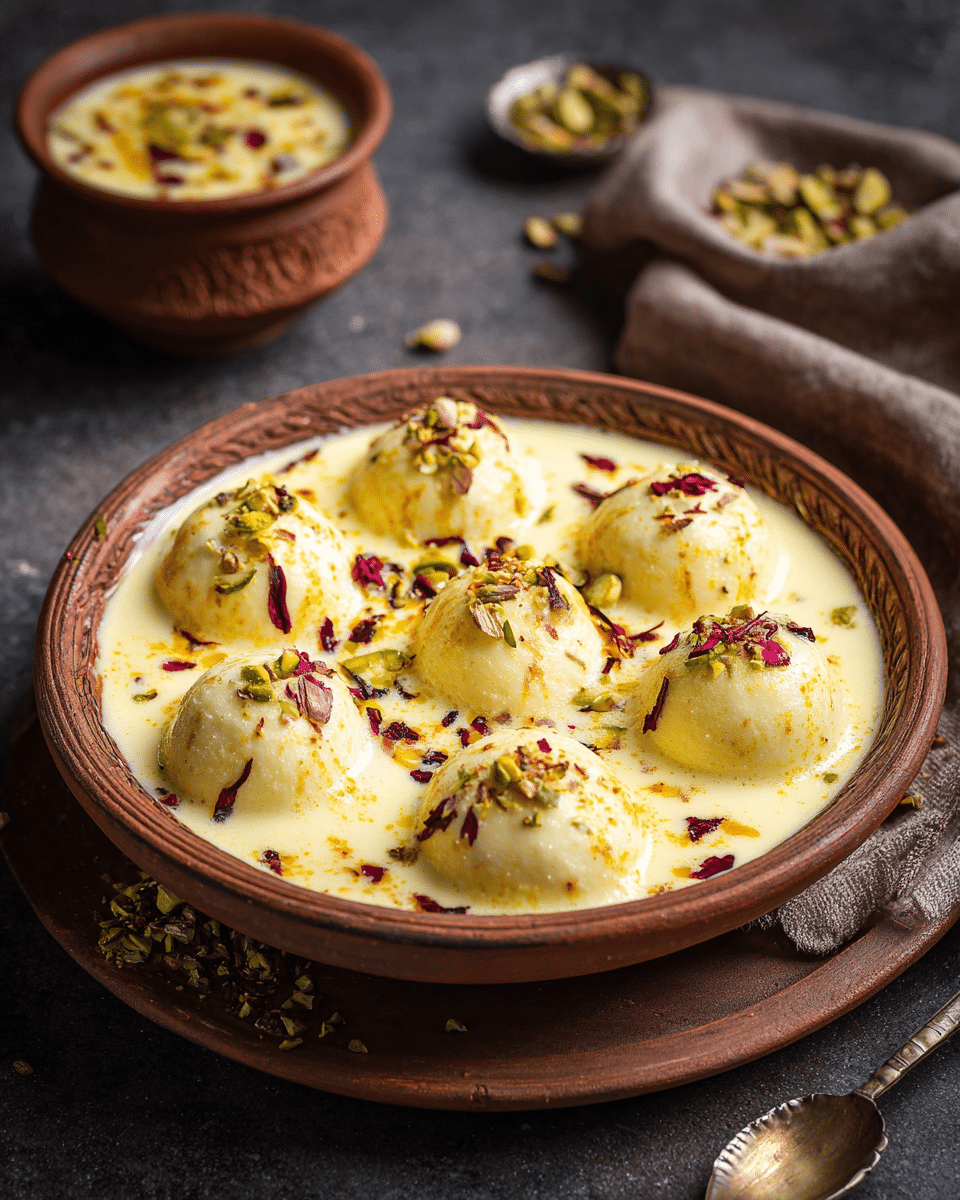Rasmalai is a luxurious and traditional Indian dessert, beloved during festivals and special occasions like Raksha Bandhan. This Rakhi Special Rasmalai features soft, spongy chhena (fresh paneer) balls soaked in a delicately flavored saffron and cardamom-infused milk. The richness of the milk, combined with the lightness of the chhena, creates a melt-in-the-mouth experience.
FULL RECIPE
Ingredients
1.For the Chhena Balls:
- 1 liter full-fat milk
- 2 tablespoons lemon juice (mixed with 2 tablespoons water)
- 4 cups water (for sugar syrup)
- 1 cup sugar
2.For the Ras (Flavored Milk):
- 1 liter full-fat milk
- 10-12 saffron strands (soaked in 2 tablespoons warm milk)
- ¼ cup sugar (adjust to taste)
- ½ teaspoon cardamom powder
- 1 tablespoon chopped pistachios
- 1 tablespoon chopped almonds
- ½ teaspoon rose water (optional)
Directions
- Prepare the Chhena: Boil 1 liter of milk in a heavy-bottomed pan. Once it comes to a boil, turn off the heat and slowly add lemon juice mixture while stirring gently until the milk curdles and whey separates. Strain using a muslin cloth and rinse the chhena under cold water to remove lemon flavor. Squeeze out excess water and hang it for 30 minutes.
- Knead the Chhena: Place the drained chhena on a clean surface and knead it with the palm of your hand for about 8-10 minutes until smooth and soft. Divide into 10-12 equal portions and roll into smooth balls. Flatten slightly to form discs.
- Cook the Chhena Discs: In a large pan, boil 4 cups water with 1 cup sugar to create a sugar syrup. Once boiling, gently drop the chhena discs into the syrup. Cover and cook on medium-high heat for 12-15 minutes. The discs will double in size. Remove them and let them cool.
- Make the Flavored Milk (Ras): In a separate saucepan, boil 1 liter of full-fat milk. Reduce the flame and simmer until it reduces to about ¾ of the original quantity. Stir occasionally to avoid burning.
- Flavor the Milk: Add saffron milk, cardamom powder, and sugar to the simmering milk. Mix well and cook for another 5 minutes. Stir in chopped nuts and rose water (if using). Turn off the heat and let the milk cool slightly.
- Assemble the Rasmalai: Gently squeeze the sugar syrup from the chhena discs and place them in the prepared saffron milk. Let them soak for at least 2-3 hours in the refrigerator.
- Garnish and Serve: Serve the Rasmalai chilled, garnished with more slivered pistachios, almonds, and a few strands of saffron.
Nutrition Facts
- Calories: 190
- Total Fat: 10g
- Saturated Fat: 5.5g
- Cholesterol: 25mg
- Sodium: 50mg
- Total Carbohydrates: 20g
- Dietary Fiber: 0.5g
- Sugars: 18g
- Protein: 6g
- Calcium: 20% DV
- Iron: 2% DV
Cultural Significance of Rasmalai During Rakhi
Rasmalai holds a cherished place in Indian festivities, especially during Raksha Bandhan, a celebration that honors the bond between siblings. It is often chosen for its royal feel and indulgent flavor, making it an ideal dessert to offer to loved ones. The richness of saffron milk combined with the softness of chhena is symbolic of the sweetness and purity of sibling relationships. Serving Rasmalai on Rakhi not only reflects love and warmth but also adds a touch of grandeur to the festival’s culinary offerings. Its inclusion in Rakhi thalis and feasts underscores its cultural prominence as a festive favorite.
The Role of Saffron and Cardamom in Flavor and Aroma
Two ingredients that define the sensory experience of Rasmalai are saffron and cardamom. Saffron imparts a warm golden hue and a distinct floral aroma that elevates the milk base into a luxurious syrup. Cardamom, with its sweet-spicy undertone, adds complexity and a soothing fragrance. These ingredients are more than just flavor enhancers; they evoke traditional Indian dessert profiles and stimulate the appetite through aroma alone. Their usage in Rasmalai not only adds authenticity but also provides a multisensory experience that is both comforting and festive.
Health Benefits of Chhena-Based Desserts
Chhena, the fresh Indian cheese used in Rasmalai, is a source of high-quality protein and calcium. Unlike heavily fried or ghee-laden sweets, chhena is steamed or cooked in sugar syrup, making it relatively lighter. It provides essential nutrients such as phosphorus and B vitamins, which are important for bone and muscle health. Moreover, the use of milk as the base enhances its nutritional value, offering good fat and aiding in digestion when consumed in moderation. For vegetarians, chhena serves as a rich, non-meat protein source, making Rasmalai a more balanced festive treat.
Modern Variations and Flavor Innovations
While traditional Rasmalai is flavored with saffron and cardamom, modern adaptations introduce a world of exciting flavors. Mango Rasmalai, rose-flavored Rasmalai, and even chocolate-infused versions have become popular, especially in contemporary Indian households and fusion restaurants. These versions retain the essence of the original but appeal to younger or more global palates. Some chefs even serve it as deconstructed desserts in glasses, layering flavored milk and mini chhena discs. These variations expand the appeal of Rasmalai beyond traditional settings, making it a dessert that can evolve while preserving its core identity.
Pairing Rasmalai with Other Rakhi Dishes
Rasmalai is best paired with lighter savory dishes typically served during Raksha Bandhan, such as vegetable pulao, paneer tikka, or samosas. Its cool, creamy texture makes it an excellent counterpoint to spicy and tangy foods, balancing the heat with sweetness. Drinks like chilled rose sherbet or cardamom chai also pair well, complementing the spice profile of the dessert. If serving a full-course meal, Rasmalai acts as the perfect finale—refreshing yet indulgent. It also pairs well with nuts or dried fruit platters for those who enjoy a more elaborate dessert presentation.
Tips for Perfect Texture and Flavor
Achieving the ideal Rasmalai requires attention to texture and flavor balance. The chhena must be kneaded thoroughly to ensure a smooth, spongy finish that absorbs the milk well. Over-kneading can make the discs too dense, while under-kneading may result in a grainy texture. The milk should be simmered slowly to develop a rich, creamy consistency without scorching. Proper infusion of saffron and cardamom is essential for an authentic taste. Allowing the prepared Rasmalai to rest in the fridge for several hours helps the flavors meld and the texture to firm up, making every bite flavorful and tender.
Storage Instructions and Shelf Life
Rasmalai is best consumed fresh but can be stored in the refrigerator for up to 3 to 4 days. It should always be kept in an airtight container to prevent the absorption of other odors and to maintain its delicate aroma. It’s not advisable to freeze Rasmalai, as freezing alters the texture of both the chhena and the milk syrup, making them grainy and less appealing. For extended freshness, garnish only before serving, and avoid keeping it out at room temperature for more than two hours, especially in warmer climates. Refrigerated Rasmalai often tastes better as it gives time for the flavors to deepen.
Serving Suggestions for Festive Presentation
To make Rasmalai visually appealing for Rakhi or any festive occasion, presentation is key. It can be served in silver bowls or decorative glassware, garnished with slivered almonds, pistachios, and a few strands of saffron for an elegant touch. Edible rose petals and a light drizzle of rose water can add to the aesthetic and aroma. For an elevated dessert table, individual servings in ramekins with miniature spoons can add charm and sophistication. When served chilled, it offers a refreshing conclusion to a warm, hearty meal, leaving guests impressed and satisfied.
Dietary Considerations and Customizations
While Rasmalai is inherently vegetarian, it can also be adapted for specific dietary needs. For those who are lactose intolerant, versions using lactose-free milk or nut-based alternatives like almond or oat milk can be explored, though the texture and flavor will vary. Sugar can be substituted with natural sweeteners like stevia or coconut sugar for a lower glycemic index option. Vegan Rasmalai versions use tofu or cashew-based ricotta substitutes for chhena and coconut milk for the ras. Though these adaptations deviate from the classic taste, they make the dessert inclusive and accessible to a broader audience.
How Rasmalai Reflects Indian Culinary Heritage
Rasmalai is more than just a dessert—it’s a reflection of India’s rich culinary heritage. Originating from Bengal and now beloved across the country, it showcases regional dairy craftsmanship and the art of balancing textures and flavors. It embodies the ingenuity of Indian sweets, where minimal ingredients transform into gourmet delicacies through technique and tradition. The process of curdling milk, creating sugar syrup, and infusing aromatic spices mirrors age-old practices passed down through generations. In serving Rasmalai, one is not just offering dessert, but a piece of history enriched with culture and pride.
Conclusion
Rakhi Special Rasmalai stands out as a festive delicacy that combines elegance, tradition, and indulgence. Its delicate balance of rich saffron milk and tender chhena is both nostalgic and celebratory, making it an essential part of Raksha Bandhan’s culinary offerings. Beyond its delightful taste, Rasmalai carries cultural significance, offers healthful elements, and adapts well to modern tastes and dietary needs. Whether served in a traditional thali or as a standalone dessert, Rasmalai captures the spirit of joy and togetherness that defines Indian festivals.






